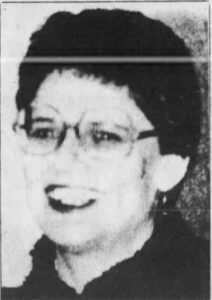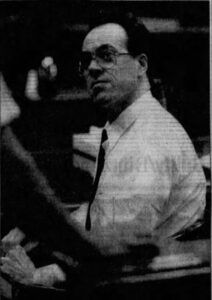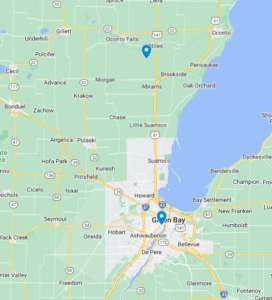- About Ramapo
- Academics
- Admissions & Aid
- Student Life
- Athletics
- Alumni
- Arts & Community
- Quick Links
- Apply
- Visit
- Give
Investigative Genetic Genealogy Center (IGG)
New lead in 1987 Wisconsin murder of Sandra Lison could produce third IGG exoneration

Image: Sandra Lison. Green Bay Press-Gazette. 6 Aug 1987.
On the night of August 3, 1987, Sandra Lison—mother of two—disappeared from the Good Times Bar in Green Bay, Wisconsin, where she worked as a bartender. The next morning, Sandra’s body was found thirty miles north, in the rural Machickanee Forest. The evidence suggested that she had been beaten, strangled, and sexually assaulted.
Investigators initially focused on finding a man whom two customers at the bar saw speaking with Sandra in the early morning hours, making him the last person in the bar before closing. The man was never identified, and the case went cold. For eleven years.
Then, in 1998, a prisoner in the Oshkosh Correctional Institution began telling guards about the nightmares of his cellmate, David Bintz. The prisoner said that David would scream in his sleep about killing a woman. According to the prisoner, David yelled to “make sure she’s dead.” The prisoner told guards that he confronted his cellmate, and David admitted to helping his brother, Robert, kill Sandra after the two went to purchase beer from the bar and were annoyed at the high price.

Image: Robert Bintz. Green Bay Press-Gazette. July 27, 2000
Reviewing their notes, investigators remembered that they had spoken to David Bintz early in the investigation, and he had told them about driving to the bar to buy beer with Robert and a friend.
At some point in the investigation, a witness claimed that David Bintz had called in a bomb threat to the Good Times Bar on the night of Sandra’s disappearance.
Based on this evidence, in 2000, David and Robert Bintz were both tried for and found guilty of the murder of Sandra Lison. Robert took the stand in his own defense and denied committing the crime.
No physical evidence tied him or his brother to the crime. Indeed, DNA extracted from semen and blood found on Sandra’s remains excluded both David and Robert.
The man seen speaking to Sandra at closing time was never identified.
The source of the DNA from the blood and semen remained a mystery.
The two brothers’ appeals failed, and they remain locked in Wisconsin prisons. But based on the physical evidence pointing to another man, the Great North Innocence Project took on Robert’s case and began searching for the true perpetrator.
Around that same time, investigative genetic genealogy began making headlines. Along with the hundreds of perpetrators and unidentified remains discovered with the help of IGG, the method had been used to help exonerate two individuals.
In the summer of 2023, the Great North Innocence Project turned to the Ramapo College IGG Center to help identify the source of the rogue DNA. Another IGG organization had worked the case diligently in the preceding two years but had been unable to narrow on a candidate.
Over the course of three days, Ramapo IGG Center staff and students in the inaugural Ramapo IGG Bootcamp worked on the case in the secure IGG Lab housed in Ramapo College’s Learning Commons.
At the end of those three days, the Ramapo IGG Center team produced a lead: genetic genealogical analysis indicated that the source of the DNA was likely one of three brothers who were living in the Green Bay area at the time.

Map shows the location of the Good Times Tavern at 1332 S. Broadway on Aug. 3, 1987 and the Machickanee Forest, where Sandra’s body was located.
One brother stood out. Just prior to the attack on Sandra at the Good Times Bar, he had been released from a long prison sentence for crimes in 1981 where he, on two separate occasions, broke into the home of the same woman, where he blindfolded and raped her.
That same brother was later charged with calling in a bomb threat to a courthouse.
Based on this tentative identification, the Great North Innocence Project secured the cooperation of the district attorney to conduct additional DNA testing and comparisons. As IGG is only a lead, that lead must be confirmed with a direct DNA comparison.
That effort is ongoing.
The Ramapo College IGG Center is proud to have provided a lead in this case, which, if successfully confirmed, may lead to only the third time that IGG has been used to exonerate a wrongfully convicted man. This case helps fulfill one of our missions at the Ramapo IGG Center which is to expand the use of IGG in securing justice for the wrongfully convicted. Our Director, Prof. David Gurney, is especially pleased as the Great North Innocence Project (then the Minnesota Innocence Project) is where he first volunteered on a wrongful conviction case in 2012.
Our team approach was pivotal in this case. With a team of eight individuals working through the genetic and genealogical clues together, in person, we were able to make connections that a practitioner working alone could not have made in such a short time.
The case could not have produced a lead so quickly without the work or the students in our weeklong, intensive IGG Bootcamp. Those students, selected as individuals with the knowledge and experience—and ethical aptitude—to hit the ground running in an IGG case, showed their dedication to justice throughout their work on the case.
At this year’s Ramapo Investigative Genetic Genealogy (RIGG) conference, Jim Mayer of the Great North Innocence Project will serve as the keynote speaker, where he will discuss this case and other innocence work. Please join us. More information at registration here: https://www.ramapo.edu/igg/conference/
If you would like to learn more about our educational offerings—including the Ramapo IGG Bootcamp—please visit our website or contact our Director, Prof. David Gurney, dgurney@ramapo.edu, or our Assistant Director, Cairenn Binder, cbinder@ramapo.edu.
Categories: exonerations
Copyright ©2025 Ramapo College Of New Jersey. Statements And Policies. Contact Webmaster.

Follow Ramapo